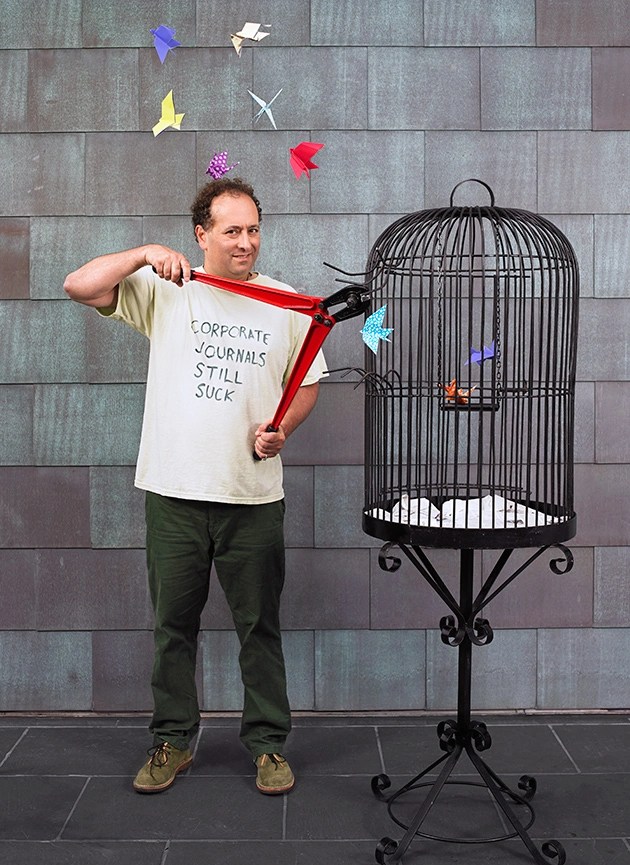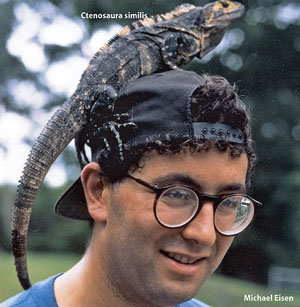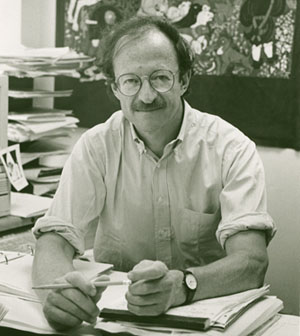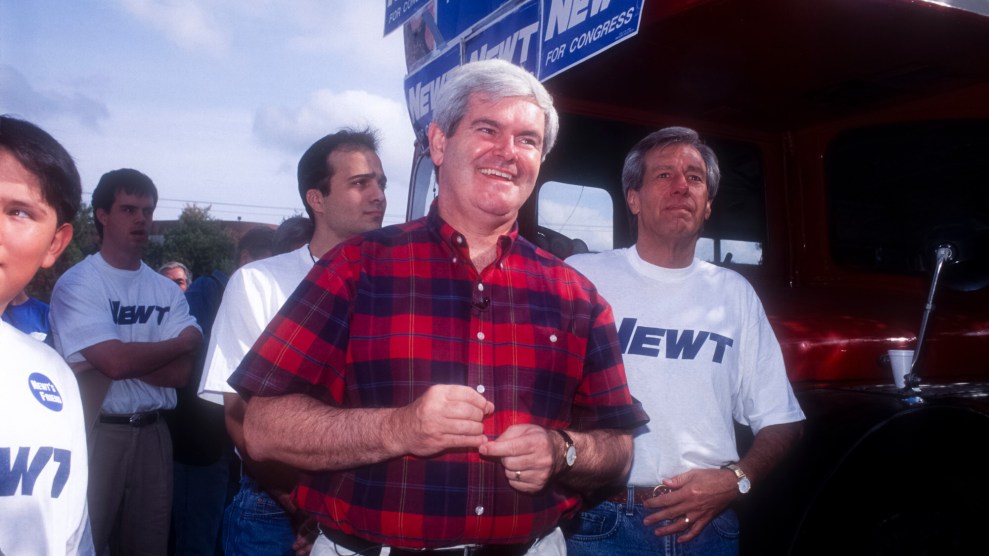
UC-Berkeley professor and PLOS cofounder Michael Eisen.
Andy Reynolds
On a frigid day in January 2011, a surveillance camera captured footage of a young man sneaking into a wiring closet at the Massachusetts Institute of Technology. Once inside, he retrieved a laptop he’d plugged into the university’s network. He then cracked the door to make sure the coast was clear and split, covering his face with a bicycle helmet to conceal his identity.
Over the previous several months, according to a subsequent federal indictment, Aaron Swartz—internet prodigy, RSS co-inventor, Reddit co-creator, and a fellow at the Center for Ethics at Harvard—had stolen nearly 5 million academic articles, including about 1.7 million copyrighted scientific papers held by JSTOR (as in “journal storage”), a digital clearinghouse whose servers were accessible via the MIT net.
To Swartz and his supporters in the “open access” movement, this was a noble crime. The taxpayer-funded National Institutes of Health (NIH) is the world’s largest funder of biomedical research. Researchers are not paid for the articles they write for scholarly journals, nor for the time and expertise they donate by peer-reviewing and serving on editorial boards. Yet the publishers claim copyright to the researchers’ work and charge hefty fees for access to it. (The average subscription to a biology journal costs $2,163.) It is “a moral imperative,” Swartz argued in his 2008 “Guerilla Open Access Manifesto,” that students, scientists, and librarians download and disseminate copyrighted scientific research to “fight back” against “this private theft of public culture.”
Swartz had intended to place the pilfered papers on file-sharing networks, free for the taking. Instead, he was arrested and charged with multiple violations of the Computer Fraud and Abuse Act, a 1986 law written with WarGames-style hacking and Cold War espionage in mind. Facing decades in federal prison, the 26-year-old, who’d struggled with depression for years, hanged himself in his Brooklyn apartment in January.
In the days following the suicide, commentators angrily pointed fingers at federal prosecutors and MIT for pursuing Swartz. But Michael Eisen, a respected fruit fly geneticist at the University of California-Berkeley, reserved a portion of the blame for his peers. Noting how sympathetic scientists had memorialized Swartz by posting free copies of their articles online, he wrote on his popular blog, it is NOT junk, “It is a tragic irony that the only reason Swartz had to break the law to fulfill his quest to liberate human knowledge was that the same academic community that rose up to support his cause after he died had routinely betrayed it while he was alive.”
By then, the 46-year-old Eisen had already spent most of his career leading a frontal assault on the very status quo that Swartz had tried to subvert. More than a decade ago, he helped launch the Public Library of Science (PLOS), a series of journals with a groundbreaking business model: All of its content is immediately published online, free and ready to be shared, critiqued, analyzed, and expanded upon in the spirit of true academic inquiry.
This radical approach was designed to undermine the traditional publishers of science journals—both nonprofit societies such as the American Association for the Advancement of Science, which publishes Science, and commercial publishers such as Elsevier, a Dutch firm whose more than 2,000 academic titles include Cell and The Lancet. In particular, PLOS (rhymes with “floss”) was an attack on those and other top-tier publications, whose appearance on a scientist’s CV can ensure plum positions and job security.
Eisen and his fellow PLOS cofounders, the Nobel laureate Harold Varmus and Stanford University professor Patrick Brown, saw the subscription-based journals as anachronisms, obstacles to scientific advancement in an era of big data. Papers take ages to get into print, and when they appear online they are hidden behind paywalls, hard to browse, and impervious to text- and data-mining techniques that could lead to new discoveries. Like your cable TV provider, the biggest publishers also bundle their products, forcing strapped university libraries to buy dozens of journals they don’t want to get the ones they need. Last year, Elsevier reported pretax profits of almost $1.3 billion, a margin of more than 30 percent.
If Aaron Swartz is the open-access movement’s first martyr, Michael Eisen is its inside agitator. Visitors to his office are greeted by a bullet-riddled wooden sign announcing “THE LAW ENDS HERE.” He shows up late to our interview clad in shorts, a backward Red Sox cap, and a yellow T-shirt that reads “Vaccinate Your Kids, You Ignorant Hippie.”
Eisen was born in Boston to a family of scientists—in an auspicious year for the Red Sox, he is quick to add. His grandfather was an x-ray crystallographer, his mother a biochemist. When he was around kindergarten age, his parents moved the family to Bethesda, Maryland, because his father, a physician, had joined the National Health Service and signed up as an NIH researcher to avoid serving in Vietnam. “It wasn’t that it was cool,” Eisen tells me. “It was just like, that’s what people did.”

Michael and his brother Jonathan, now an evolutionary biologist at UC-Davis, spent their childhood summers at their grandparents’ beach house on Long Island, exploring nature. “I liked catching animals,” Eisen says. “I liked frogs and salamanders. Even more than I have a frog fetish, I have a swamp fetish. I really like being in swamps.”
His Red Sox obsession aside, Eisen was never much of a ballplayer. Math was his game. He was captain of his county math team in high school and even won the Maryland state math competition. After high school, he set off to Harvard University intent on becoming a mathematician, but changed course after he encountered classmates reminiscent of Matt Damon’s genius in Good Will Hunting. “There were a couple people who would ask questions that would make the professor stop lecturing,” Eisen recalls. “I can think of no field at all where being second best is less appealing than math. Every 10 years, there are five fat problems that get solved and are really important, and everybody else is just filling in blanks. From that point on, I knew I wasn’t going to be a mathematician. You don’t want to be Salieri to Mozart.”
He got an early taste of the high-stakes intersection of science and politics one day in 1987 when his uncle showed up at his dorm room with devastating news: His father had hanged himself. Howard Eisen had reported an NIH colleague for scientific fraud, and the agency held a hearing to which the elder Eisen showed up but the accused scientist did not. “I don’t know what happened at this meeting, but somehow my father left feeling that he was under suspicion—something everyone involved knew he was not. But whatever happened, it set something off,” Eisen wrote on his blog earlier this year. “I felt, for a long time, that the faceless people on that NIH committee had literally killed my father, just like so many people seem to think [federal prosecutor] Carmen Ortiz killed Swartz.”
Eisen remained at Harvard for graduate school, unlocking the three-dimensional structures of proteins. In 1996, around the time he got his Ph.D. in biophysics, he learned of a thrilling new technology. David Botstein, a celebrated scientist who was in Boston on business, showed him a DNA microarray, or “gene chip,” developed by his colleague Pat Brown at Stanford.
Brown had developed a robotic dispenser that could deposit minute quantities of tens of thousands of individual genes onto a single glass slide (the chip). By flooding the slide with fluorescently labeled genetic material derived from a living sample—say, a tumor—and seeing which parts of the chip it adhered to, a researcher could get a big-picture glimpse of which genes were being expressed in the tumor cells. “My eyes were opened by a new way of doing biology,” Eisen remembers.
After a slight diversion—he was hired as the summer announcer for the Columbia Mules, a minor-league baseball team in Tennessee—Eisen joined Brown’s team as a postdoctoral fellow. “More than anything, his lab influenced the idea of thinking big and not being hemmed in by traditional ways people do things,” he says. “Pat is, by an order of magnitude, the most creative scientist I’ve ever worked with. He’s just in another plane. The lab was kind of in some ways a chaotic mess, but in an academic lab, this is great. We had a technology with an unlimited potential to do new stuff, mixed with a bunch of hard-driving, creative, smart, interesting people. It made it just an awesome place to be.”
The lab also had something of a rebel streak that foreshadowed the creation of PLOS. In early 1998, Affymetrix, a biotech firm that had developed its own pricier way to make gene chips, filed a lawsuit claiming broad intellectual rights to the technology. Worried that a ruling in the company’s favor would render gene chips and the machines that made them unaffordable, Brown’s lab posted step-by-step instructions on the lab’s website, showing how to build your own machine at a fraction of the cost.
The microarray experiments, meanwhile, were yielding mountains of data—far more than Brown’s team could process. Eisen began writing software to help make sense of all the information. Previously, most molecular biologists had focused on no more than a handful of genes from a single organism. The relevant literature might consist of a few hundred papers, so a dedicated scientist could read every one of them. “Shift to doing experiments on the scale of thousands of genes at a time, and you can’t do that anymore,” Eisen explains. “Now you’re talking about tens, if not hundreds, of thousands of papers.”
He and Brown realized that it would be immensely helpful to cross-reference their data against the existing scientific literature. Conveniently, the Stanford library had recently launched HighWire Press, the first digital repository for journal articles. “We marched down there and told them what we wanted to do, and could we have these papers,” Eisen recalls. “It didn’t occur to me that they might say no. It just seemed such an obvious good. I remember coming back from that meeting and being like, ‘What a bunch of fuckin’ dicks! Why can’t we have this stuff?'”
The lab’s gene-chip battle, Eisen says, had “inspired a similar attitude with what ultimately became PLOS: ‘This is so ridiculous. We can kill it!'” Brown, luckily, had friends in high places. Harold Varmus, his own postdoctoral mentor, was then in charge of the NIH—one of the most powerful jobs in science. The NIH doles out more than $20 billion annually for cutting-edge biomedical research. Why, Brown asked Varmus, shouldn’t the results be available to everyone?

The more Varmus thought about this, he wrote in his memoir, The Art and Politics of Science, the more he was convinced that “a radical restructuring” of science publishing “might be possible and beneficial.” As he explained to me in a phone interview, “You’re a taxpayer. Science affects your life, your health. Don’t you want to be able to see what science produces?” And if not you personally, then at least your doctor. “The current system prevents medically actionable information from reaching people who could use it,” Eisen says.
Varmus had experienced the system’s absurdities firsthand. In his book, he recalls going online to track down an electronic copy of the Nature paper that had earned him and J. Michael Bishop the 1989 Nobel Prize in Physiology or Medicine. He couldn’t even find an abstract—only a poor quality scan on Google Scholar that another professor had uploaded for his class.
In May 1999, following some brainstorming sessions with his colleagues, Varmus posted a “manifesto” on the NIH website calling for the creation of E-biomed, an open-access digital repository for all agency-funded research. Researchers would have to place new papers in the archive even before they ran in print, and the authors would retain copyright. “The idea,” Eisen says, “was basically to get rid of journals, more or less entirely.”
The publishers went ballistic. They deployed their top lobbyist, former Colorado Rep. Pat Schroeder, to put heat on the members of Congress who controlled Varmus’ budget. Rep. John Porter (R-Ill.), one of Varmus’ biggest supporters on the Hill, summoned the NIH chief into his office. “He was obviously beaten up by Schroeder,” Varmus told me. “He was concerned that the NIH was going to get a black eye from scientific societies and other scientific publishers, and that he was going to be pilloried, even by his colleagues, for supporting an organization that was undermining a strong American business.” Varmus had to convince his friend “that NIH was not trying to become the publisher; the publishing industry might make less profit if we did things differently—but that was okay.”
E-biomed “was basically dead on arrival,” Eisen says. “The societies said it was gonna ruin publishing, it was gonna destroy peer review, it was gonna lead to government control of publishing—all complete bullshit. Had people let this go forward, publishing would be 10 years ahead of where it is now. Everything would have been better had people not had their heads up their asses.”
Three months later, the NIH came back with a compromise engineered by David Lipman, the agency’s computer guru. Publishers were asked to submit their papers to a new database called PubMed Central within six months of publication. The journals, not the authors, would retain copyright. And the biggest compromise: Participation was voluntary. The hope, Eisen says, was that the “good guys” (the scientific societies) would do the right thing, and the “bad guys” (the commercial publishers) would look bad and eventually cave in.
It was wishful thinking. Most of the societies refused to participate—even after the proprietary period was extended to a year. “I still feel quite miffed,” says Varmus, who now runs the National Cancer Institute, “that these scientific societies, which should be acting like guilds to make our enterprise stronger, have been terribly resistant to advances in the publishing industry.”
In September 2000, fed up with the recalcitrance of the publishers, Eisen, Brown, and Varmus staged a boycott. In an open letter, they pledged that they would no longer publish in, subscribe to, or peer-review for any journal that refused to take part in PubMed Central. Nearly 34,000 researchers from 180 countries signed on—but this, too, was a bust. “The publishers knew they had the scientists over the barrel,” Eisen says. “They called our bluff. This all happened right as I got hired at Berkeley, and I was very clearly advised by my colleagues that I was being insane. I would never get tenure if I didn’t toe a more traditional publishing line.”
The only option left for Eisen and his partners was to back down or become publishers themselves.
They decided to chance it. Their biggest obstacle out of the gate was what’s known as the “impact factor.” The pecking order of academic publications is determined by how often their articles are cited by others; more citations means a higher impact factor. In a system where career prospects are measured as much by where you publish as what you publish, impact is everything, the difference between getting hired by a top-tier university versus some college in the sticks. An ambitious young researcher would be crazy to pass up the chance of placing an article in journals like Cell or Nature or the New England Journal of Medicine.
One British publisher, in a clear nod to the NIH’s efforts, had already launched an open-access site called BioMed Central. But Varmus worried that it didn’t aim high enough. The view among scientists at the time, he explains, was that free publications would be “vanity press and bottom-feeding”—too low-impact to attract great papers. To overcome this, Eisen says, PLOS would have to “get people comfortable with the idea of open access by introducing journals that looked and functioned just like the snottiest journals they knew, but used a different economic model.”
The business plan was relatively simple: PLOS journals would cover expenses by charging a per-paper publication fee (currently a sliding scale from free to $2,900) that researchers could write into their grant proposals. The founders secured a $9 million startup grant and raised eyebrows by poaching respected editors from Cell, Nature, and The Lancet. They recruited a star-studded board of directors that included Creative Commons founder Lawrence Lessig and Gates Foundation CFO Allan Golston. And they fought hard for highly regarded papers, including one from Eisen’s own brother, who was being courted by Science and Nature. Not long after the October 2003 debut of their flagship title, PLOS Biology, it was rejecting loads of submissions, just like any elite journal. “In some ways, we had to become what we loathed,” Eisen says.
Next came PLOS Medicine, followed by a series of publications tailored to specific research areas like genetics and computational biology. But the game-changer, Eisen says, was PLOS ONE, a web-only journal unveiled in December 2006. It was precisely the sort of publication its founders originally had envisioned. Papers are peer-reviewed for scientific rigor, but not for importance—that’s for the research community to determine. With more than 23,000 papers published last year, it is now the world’s most prolific science journal.
The year after PLOS ONE went online, open-access advocates scored another victory: Congress passed a bill forcing life-science publishers to send NIH-funded papers to PubMed Central within 12 months of publication. The papers could only be read online and not downloaded, but it was a start.
Still, the industry has engineered at least two attempts to gut the NIH policy, including the Research Works Act, introduced in 2011 by Reps. Carolyn Maloney (D-N.Y.) and Darrell Issa (R-Calif.). Elsevier, the bill’s main supporter, backed off after mathematicians boycotted the company and Eisen publicized a bunch of interestingly timed donations from company execs to Maloney. “The Elsevier people were referring to the bill as their bill—they’re just so dumb!” he says.
In February, amid the furor surrounding Swartz’s death, the White House ordered all federal agencies with research expenditures greater than $100 million to propose policies that would let anyone read, download, and data-mine publicly funded papers after a waiting period—an apparent improvement over the NIH policy. In response, the Association of American Publishers has lobbied for an open-access portal run by the industry. Eisen likens it to letting the NRA control firearms background checks. (Coincidentally, the AAP’s earlier campaign against open access was dubbed PRISM, the same acronym the NSA used for the spying operation exposed by Edward Snowden.)
The publishers insist that they add value to the papers by coordinating peer review and determining which ones are noteworthy, and thus should be allowed to maintain control over their products. “We believe that the publication and dissemination of research articles is best left to a free market,” executives of the Genetics Society of America, the publisher of the journal Genetics, wrote to the Obama administration. “The primary scientific literature is often highly technical and specific and generally not understandable to a general audience. Enabling public access will, thus, generally not advance public knowledge or understanding.”
But the PLOS model is only gaining steam. Now that it’s clear you can give away content and still make money, many publishers have launched their own open-access experiments. Even Elsevier now offers an “author pays” open-access option with more than 1,600 of its journals, and 40 use it exclusively. ELife, a nonprofit initiative created recently by big-name scientists and major foundations, promises to push the industry even further in that direction.
While PLOS has triggered a quiet revolution in academic circles, Swartz’s death has sparked public interest in open access and compelled privacy and internet freedom groups to pick up the banner. “After Aaron’s death, we figured it should be something we focused more on,” explains Adi Kamdar of the Electronic Frontier Foundation. “We think it is a transparency issue. People should know how government money is being spent and have access to what comes out of it.”
The Obama administration’s research-sharing directive, the response to a We the People petition, came shortly after Swartz’s suicide, as did a new bipartisan bill that would require publishers to make most federally funded research freely available within six months of publication. Robert Swartz, who has been publicizing his son’s cause, says, “I’ve never met an academic who wants their research behind a paywall.”
In the meantime, Michael Eisen may have found a way to do what Aaron Swartz was trying to do without sacrificing life, liberty, or career. For nervous scientists looking for evidence that they can abandon the paywalled journals, he offers himself as Exhibit A. Eisen earned his tenure from Berkeley and landed the prestigious title of investigator at the Howard Hughes Medical Institute even though his lab publishes exclusively in open-access journals. Some people will cling to the old ways until the bitter end, he says, but “it’s basically inevitable that this is going to be the dominant mode of scientific publishing.”
In the end, his disdain isn’t directed at the publishers who hoard scientific knowledge so much as at his colleagues who let them get away with it. “One of the reasons advances in publishing don’t happen is that people are willing to live with all sorts of crap from journals in order to get the imprimatur the journal title has as a measure of the impact of their work,” Eisen says. “It’s easy to blame Elsevier, right? To think that there’s some big corporation that’s preventing scientists from doing the right thing. It’s just bullshit. Elsevier doesn’t prevent anyone from doing anything. Scientists do this themselves!”
















